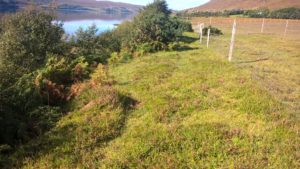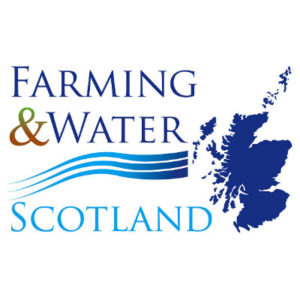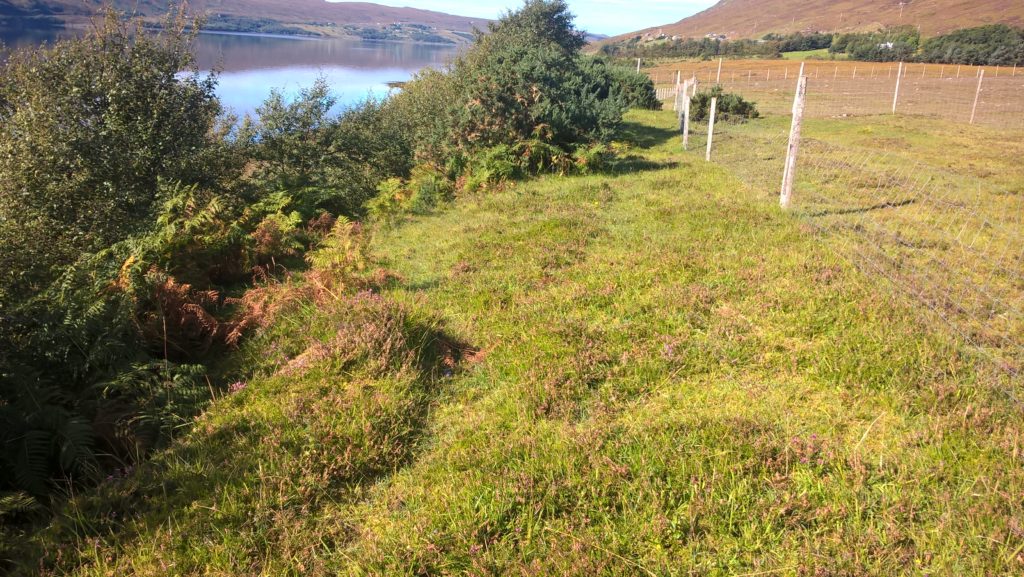AECS & Pains on the Croft – Event Summary
30 September 2017This was a j oint meeting between FAS & the Soil Association (Scotland) and was held on a working croft near Ullapool. The event was dedicated to helping crofters identify habitats and management that would is beneficial to the environment.
oint meeting between FAS & the Soil Association (Scotland) and was held on a working croft near Ullapool. The event was dedicated to helping crofters identify habitats and management that would is beneficial to the environment.
Habitats that are commonly found on Highland crofts includ species rich grassland, wetland, unimproved acid grassland/grass heath, scrub and water margins. The group discussed  the identifying features of each habitat type, the wildlife they support, and how they can be managed to enhance or improve their condition.
the identifying features of each habitat type, the wildlife they support, and how they can be managed to enhance or improve their condition.
An in-depth discussion covered different options for fencing and managing grasslands, as well as capital options that would be beneficial for long term improvements to the croft and its infrastructure. Advice on reducing diffuse pollution was provided and included how to reduce erosion and run off into ditches, watercourses and moorlands to benefit priority water catchments and livestock biosecurity. You can read more on how to reduce diffuse pollution on the Farming And Water Scotland website.
During the afternoon session, the group were taken through the basic principles sustainable grazing management, how to access information about local wildlife priorities, and how working as a community can provide long term benefits and help share workload, machinery and skills.
Funding may be available to assist with priority habitat management and diffuse pollution mitigation measures under the Agri-Environment Climate Scheme (AECS) from The Scottish Government. Full details on options for which your holding may be targeted for are available on the Rural Payments & Services webpage. The next round of AECS will open in January 2018.
Downloads related to the topics discussed at this meeting are available below.
- Croft and Small Farm Advisory Service Subscription Form
- Crofting Agricultural Grant Scheme Common Grazings
- Topics: Crofts & Small Farms and New Entrants
- Registering a Croft or Small Holding for Cattle and Sheep
- Starting crofting or farming can be a complicated process. Researching which organisations you need to register with and finding the forms you have to fill in is usually the first step. This practical guide is aimed at assisting you through the registration process when acquiring land, cattle and sheep.
- Topics: Crofts & Small Farms
- One-to-one support for new entrants
- One-to-one advice and grant support for new entrants to farming and crofting
- Technical Note (TN686): Conservation Grazing for Semi-Natural Habitats
- Grazing is an important process in maintaining semi-natural grasslands, wetlands and heathlands of conservation interest. This technical note provides guidance on developing grazing plans for a range of habitats in Scotland.
- Technical Note (TN688): Management and Conservation for Farmland Waders
- Five wading bird species are among the highest wildlife conservation priorities on Scottish farmland. This technical note details each of these species, including their decline and how you can manage land to help protect them.
- Technical Note (TN665) – Alternative watering for field grazed livestock I – Abstraction systems
- Topics: Water Management
- Technical Note (TN665): Alternative Watering for Field Grazed Livestock I – Abstraction Systems
- This technical note presents two different abstraction point designs to supply an alternative watering system, based on findings from Scottish Government funded trial work on three farms in Scotland.
- Topics: Water Management and Livestock
- Valuing Your Soils – Practical Guidance for Scottish Farmers
- This brochure includes useful information about Scotland's agricultural soils and practical advice outlining the upfront financial savings and business benefits of better soil management and the efficient use of resources. Action and problem-specific 'field-sheets' are designed for busy farmers with limited time for reading.
- Topics: Climate Change, Soils, Water Management and Crops and Soils
- GAEC 1 – Buffer strips along water courses
- The aim of GAEC 1 rules is to protect water against pollution and run-off.
- Topics: Rural Business
- GAEC 3 – Protection of groundwater against pollution
- The aim of GAEC 3 rules is to protect groundwater against pollution.
- Topics: Rural Business
- GAEC 4 – Minimum soil cover
- The aim of GAEC 4 rules is to protect soil against erosion after harvest until the end of winter (winter is up to and including the last day of February).
- Topics: Rural Business
- GAEC 5 – Minimum land management reflecting site specific conditions to limit erosion
- The aim of GAEC 5 rules is to protect soil against erosion in certain situations.
- Topics: Rural Business
- GAEC 6 – Maintenance of soil organic matter
- The aim of GAEC 6 rules is to maintain soil organic matter levels.
- Topics: Rural Business
- GAEC 7 – Retention of landscape features
- The aim of GAEC 7 rules is to protect landscape features.
- Topics: Rural Business
Sign up to the FAS newsletter
Receive updates on news, events and publications from Scotland’s Farm Advisory Service

